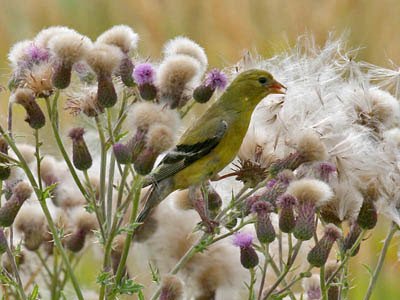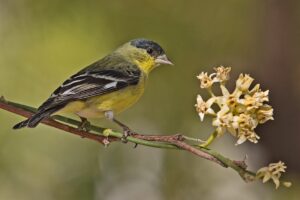Last Updated on January 26, 2024 by Greg Gillson
American Goldfinches are the bird equivalent of a bright yellow sunflower! Showy and desirable.
These are one of the favorite feeder birds throughout the United States. They arrive in the northern states in spring and remain through the fall. Southward, they are year-round visitors to bird feeders, but molt into a dull plumage for winter.
How do you attract American Goldfinches to your feeder? Follow these suggestions to attract American Goldfinches to your yard.
 |
| American Goldfinch in breeding plumage. Greg Gillson |
Why attract American Goldfinches to your bird feeder?
Tiny and colorful, American Goldfinches provide a welcome splash of color at your bird feeder.
Goldfinches don’t take over a bird feeder, as some other larger birds. They squabble a bit but don’t chase away other birds. They are used to feeding in flocks and do so at your feeder throughout the year.
They are easy to attract to your feeders. They only eat certain seeds. You can attract them without attracting other birds, if you wish.
They have bright, cheerful, twittering calls and songs.
For all these reasons and more, people who feed birds love to have American Goldfinches as regular visitors.
 |
| American Goldfinch in winter plumage |
What foods will attract American Goldfinches to your feeder?
American Goldfinches are granivores. They only eat small seeds.
American Goldfinches love to eat black oil sunflower seeds. They prefer to eat these from the shell. So there’s no need to buy more expensive hulled sunflowers or sunflower chips.
The other seed that American Goldfinches love is Niger seed, trademarked as Nyjer, and both pronounced the same way. These small seeds are eaten almost exclusively by birds in the goldfinch family (also including siskins and redpolls).
You can also feed mixed bird seed and attract goldfinches. But they’ll only eat the sunflower seeds. They may toss out the other seeds and grains.
The best mixed bird seed that I have found is Wagner’s Songbird Supreme. It is 50% sunflower seeds and doesn’t have any cheap filler seed that birds won’t eat. This seed attracts the largest variety of birds to your feeder.
 |
| Juvenile plumage of American Goldfinch in fall. |
What kind of feeders do American Goldfinches like?
American Goldfinches prefer to eat from tube feeders. These feeders with their smaller perches discourage larger birds. You may see these advertised as finch feeders.
I really love the way my Biorn tube feeder looks, with it’s copper top. A screwdriver takes off the lower perch and opens it up for cleaning. This feeder filled with black oil sunflower seeds attracts all types of finches, chickadees, and nuthatches. The smaller perches and lack of tray mean that you’ll have fewer House Sparrows, Starlings, Doves, and Jays at this feeder.
If you are feeding Niger seed, then you need to purchase either a thistle sock or thistle feeder.
Where to place your bird feeder for American Goldfinches
American Goldfinches aren’t too picky about where you place their bird feeder. They like small bushy trees separated by open spaces.
Perhaps the best location would be to place your tube feeder hanging from a branch about 5 feet high. This keeps them up above any cats that might stop by. Then they can fly up higher in the tree if they feel threatened.
You’ll want to see and enjoy your bright yellow goldfinches. So you’ll want to make sure you have a clear view of the feeder out your window from your favorite easy chair!
If you don’t have a tree placed strategically in view from your window, then set up a sturdy shepherd’s hook designed to hold bird feeders. Check your home and garden center for a solid metal shepherd’s hook about 90 inches tall. This allows tines to pound into the ground and a tube feeder to hang down from it, and still be 4 feet above the ground.
 |
| Female American Goldfinch |
How else can you attract American Goldfinches to your yard?
American Goldfinches are also attracted to bird baths and fountains. Any water feature you can add to your yard will probably interest them.
American Goldfinches love to eat the tiny seeds found in dandelions and thistles. They will come to your garden for sunflowers and other flowers in the daisy, aster group.
The goldfinches also line their nests with thistledown and similar plant material. They build cup nests in willows and wild rose and other low bushy trees.
Problems with American Goldfinches: If you have attracted too many to your feeder
Sometimes, in winter, hordes of finches catch a communicable finch disease. This can be spread at feeders.
Then, local wildlife officials may request people to stop feeding birds for a time. This announcement often appears on the daily local news channels.
This doesn’t often happen with goldfinches. But if it does, stop all feeding of mixed seeds, sunflower seeds, and Niger seed. Take down your feeders and clean them with bleach.
Likewise, if you see dead or lethargic birds around your feeder, do the same. Keep the feeders down for 2 or 3 weeks.
Alternatively, you may have a small bird-eating hawk take up residence near your feeders. They may pick off 3 or more small birds per day. This may be another reason you may want to stop feeding for a couple of weeks. Then the hawk will move on.
As mentioned, goldfinches only eat seeds. One common food that attracts birds, but not goldfinches, is suet.
For my home feeders, I always purchase St Albans Bay Suet blocks. It comes in several flavors, including peanut and berry. They fit in required special suet cages, which are a type of bird feeder.
I bought a Nature’s Way Upside-down suet feeder a couple years ago and have been very happy with it. Chickadees, nuthatches, bushtits, and woodpeckers eat from it easily. But starlings, blackbirds, and jays can’t hang upside down to get at the suet.
Wrapping Up
The American Goldfinch, with its vibrant colors and cheerful song, is a beloved bird across North America. Here are some interesting facts about these little beauties:
Appearance and Lifestyle:
- Master of Molting: Unlike most birds, the American Goldfinch undergoes a complete molt twice a year! This dramatic transformation changes their plumage from the dull brown of winter to the stunning bright yellow of summer, making them nearly unrecognizable between seasons.
- Seed Specialists: These birds are strict vegetarians, with a particular fondness for thistle seeds. Their conical beaks are perfectly adapted for extracting seeds from even the tiniest flower heads.
- Feathered Acrobats: Agile and energetic, American Goldfinches are adept at hanging upside down while feeding, accessing seeds in ways other birds can’t.
- Songbirds Extraordinaire: Their sweet, melodic songs are a hallmark of summer. Males use these complex tunes to attract mates and defend their territories.
Interesting Tidbits:
- State Bird Status: The American Goldfinch is the official state bird of New Jersey, Iowa, and Washington.
- Feathery Fashionistas: They are sometimes called “Wild Canaries” due to their resemblance to domesticated breeds.
- Bird Feeder Favorites: Their love for thistle seeds makes them frequent visitors to bird feeders, bringing joy to backyard birdwatchers.
- Nature’s Little Architects: Their skillful nest building has even earned them the nickname “Architect Finch.”
Frequently Asked Questions
Is it rare to see an American Goldfinch?
No, seeing an American Goldfinch is not considered rare in most parts of their range:
- Widespread: They are found across North America, from Canada down to Mexico, and are quite common throughout their habitat.
- Adaptable: They thrive in a variety of open areas, including meadows, grasslands, parks, gardens, and even backyards with bird feeders.
- Abundant: Their population is healthy and even increasing in some areas.
However, seeing them can depend on some factors:
- Season: They are most visible during the breeding season (spring and summer) when males sport their vibrant yellow plumage. In winter, their coloration becomes duller, making them harder to spot.
- Location: While widespread, their numbers might vary depending on specific habitats within their range.
- Individual experience: Your personal birding habits and location will influence how often you encounter them.
What is the difference between Lesser Goldfinch and American Goldfinch?


Both Lesser and American Goldfinches are beautiful songbirds with vibrant yellow plumage, but they have some distinct differences:
Appearance:
- Size: The American Goldfinch is slightly larger than the Lesser Goldfinch, measuring around 5 inches long compared to the Lesser’s 4.4 inches.
- Male Plumage:
- American Goldfinch: Bright yellow body with black wings and a black cap. In winter, the yellow tones dull down significantly.
- Lesser Goldfinch: Generally less vibrant yellow, with black backs and green-black backs in some populations. Winter plumage shows less dramatic change.
- Female Plumage: Both have brownish-gray upperparts and yellowish underparts, but:
- American Goldfinch: Females lack the white rectangular wing patch and have white undertail coverts.
- Lesser Goldfinch: Females have a faint white rectangular wing patch and yellowish undertail coverts.
Range:
- American Goldfinch: Widespread across North America, from Canada to Mexico.
- Lesser Goldfinch: Primarily found in the western United States, Mexico, and parts of Central and South America.
Habitat:
- American Goldfinch: Adaptable to diverse open areas, including meadows, grasslands, parks, and backyards.
- Lesser Goldfinch: Prefers arid regions like scrublands, canyons, and desert edges.
Are goldfinches aggressive to other birds?
While generally sociable and peaceful birds, American Goldfinches can exhibit aggressive behavior towards other birds in certain situations. Here’s a breakdown:
When are they aggressive?
- Competition for food: This is the most common reason for goldfinch aggression. They fiercely defend their access to food sources, especially at bird feeders, and may chase away smaller birds like chickadees and sparrows. They might even dive-bomb competitors or use vocalizations to intimidate them.
- Protecting their nests: During breeding season, goldfinches become highly protective of their nests and young. They might attack any perceived threat, including other birds, who get too close.
- Dominance within flock: Even within their own flocks, there can be hierarchies, with dominant individuals being more aggressive towards subordinates to maintain their position.
Related:
Why aren’t birds coming to your feeder?
3-part article on American Goldfinches
First in series: Irresistible! Attract Mourning Doves to your feeder
Next in series: Irresistible! Attract White-crowned Sparrows to your feeder









